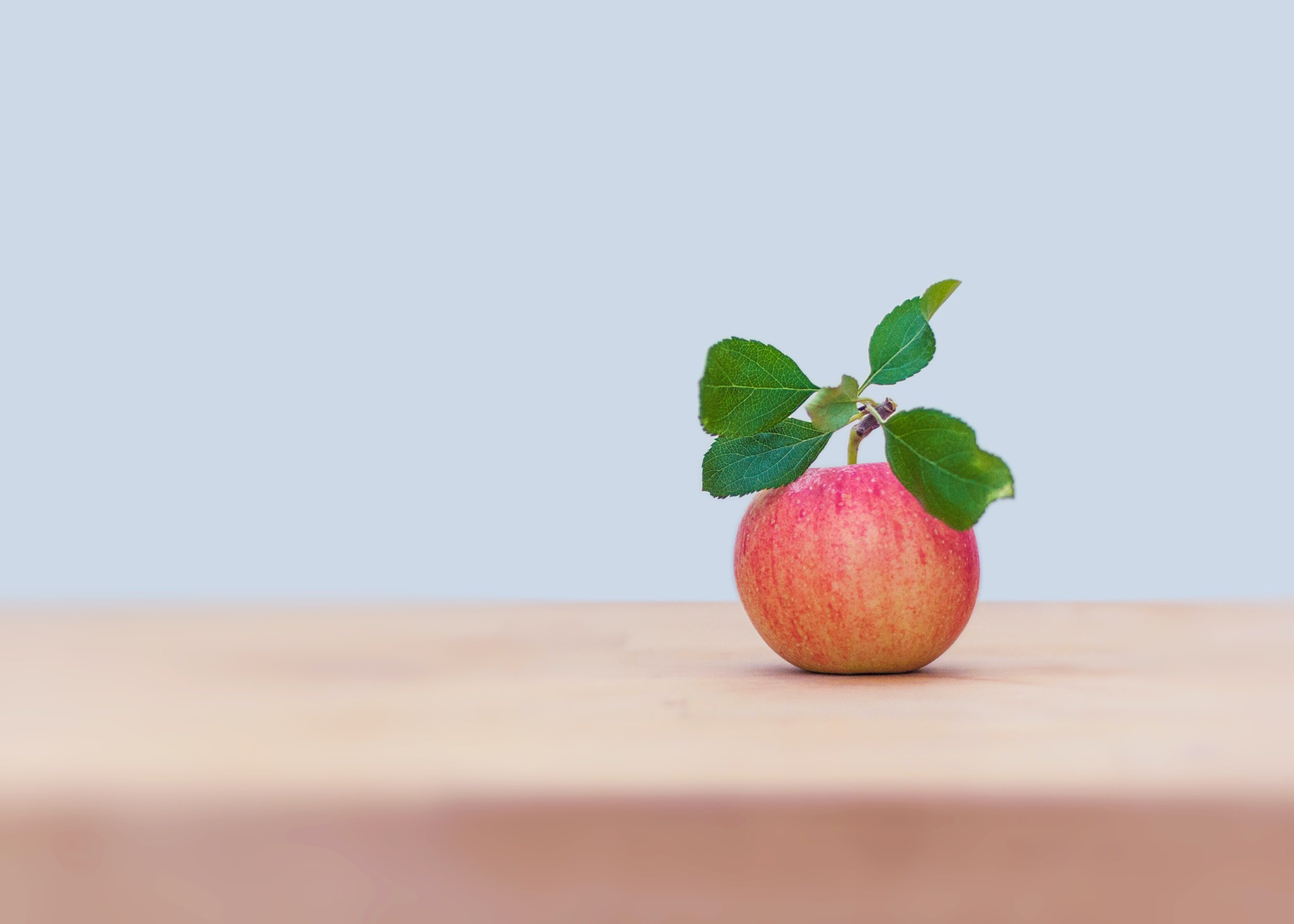Grandma knew best: Stewed apples
Forget your expensive, fancy superfoods, when it comes to the gut the apple, and in particular the stewed apple, is a POWERHOUSE! It turns out that, like always, grandma knew best when she served up stewed apples on the regular! Whether she knew what she was doing or not, those stewed apples she served supported the health of the gut microbiome, intestinal wall integrity (no leaky gut!) and helped reduce allergy and inflammation. A highly recommended addition to the daily diet after antibiotic treatment and to support overall gut and digestive health.
Beneficial bacteria in the gut convert the pectin in the apples into short chain fatty acids (SCFAs) which maintain the health of the beneficial bacteria themselves and the cells lining the colon. [1, 2, 3] Pectin even binds with (and aids the elimination of) some heavy metals and toxins from your body [4]
This applies to raw apples too, but stewed apples are easier on the digestive system if there is any inflammation and stewing the apples releases the pectin more effectively. Read the rest of the article below to see what some additional research says about the humble apple: anti-inflammatory, allergy reduction and more.
This recipe also contains PHGG (partially hydrolyzed guar gum). PHGG is a prebiotic fibre. Prebiotics are the fuel that FEED the beneficial bacteria and positively influence the composition of the gut microbiome. It is a gentle stool bulking agent and is effective at balancing bowel movements – both constipation and diarrhea (or loose stools). Its incredibly well tolerated and is my go-to prebiotic even in cases of SIBO (small intestinal bacterial overgrowth) and IBS (irritable bowel syndrome) and for babies (over 3 months) [5, 6].
PHGG increases levels of bacteria that produce SCFAs and Bifidobacterium. [7]. These bacteria play a role in making endogenous B vitamins and building our anti-anxiety neurotransmitter, GABA.
The addition of cinnamon not only supports the flavour but has anti-inflammatory [8] and blood-sugar regulating (insulin modifying) effects which can further support metabolism of the natural sugars in the apples [9].
Ingredients
Stewed organic apples in mason jars.
6 organic apples
2 tsp ground cinnamon
¼-1/2 cup water
1-2 tablespoons PHGG
Method:
Core and chop apples (leaving the skin on).
Place all ingredients in covered pot or pan.
Cook on medium heat for about 20-30 minutes (until soft and peel starts to come away)
Phenolic compounds, dietary fibre, and minerals are higher in apple peel, compared to other edible parts. Therefore, it’s a good idea to leave apple peel on some, or all, of the slices to add additional benefits.
Cooked apples can be stored for about 3-4 days in a fridge, and last considerably longer in a mason jar in the fridge.
They may be frozen and reheated as required and can be eaten warm or cold!
Some more from what the science says.
Consumption of PHGG may have benefits for cardiovascular health, decreasing both total and LDL cholesterol [10].
Intake of apples, pears and carrots has been found to be inversely associated with rhinitis, asthma, and atopic sensitization, enabling the immune system to be better equipped to handle exposure to other antigens [11]
There is also an inverse relationship between apple consumption and serum CRP (C-Reactive Protein), which is a marker of acute inflammation [12]
Apples support immune regulation and reduce mucosal sensitivity by reducing mast cell degranulation (which suppresses histamine) [13]
Food as medicine!
Sadly my husband is allergic to apples but substituting with pears still provides many health benefits and is equally delicious!
References:
1. Shinohara K, Ohashi Y, Kawasumi K, Terada A, Fujisawa T. Effect of apple intake on fecal microbiota and metabolites in humans. Anaerobe. 2010 Oct;16(5):510-5. https://pubmed.ncbi.nlm.nih.gov/20304079/
2. Selma MV, Espín JC, Tomás-Barberán FA. Interaction between phenolics and gut microbiota: role in human health. J Agric Food Chem. 2009 Aug 12;57(15):6485-501 https://pubmed.ncbi.nlm.nih.gov/19580283/
3. Titgemeyer EC, Bourquin LD, Fahey GC Jr, Garleb KA. Fermentability of various fiber sources by human fecal bacteria in vitro. Am J Clin Nutr. 1991 Jun;53(6):1418-24. https://pubmed.ncbi.nlm.nih.gov/1852091/
4. Wikiera A, Irla M, Mika M. [Health-promoting properties of pectin]. Postepy Higieny i Medycyny Doswiadczalnej. 2014 Jan;68:590-596. https://europepmc.org/article/med/24864109
5. Niv, E., Halak, A., Tiommny, E. et al. Randomized clinical study: Partially hydrolyzed guar gum (PHGG) versus placebo in the treatment of patients with irritable bowel syndrome. Nutr Metab (Lond) 13, 10 (2016). https://doi.org/10.1186/s12986-016-0070-5
6. Mahendra P. Kapoor, Masaaki Sugita, Yoshitaka Fukuzawa, Tsutomu Okubo. Impact of partially hydrolyzed guar gum (PHGG) on constipation prevention: A systematic review and meta-analysis, Journal of Functional Foods, Vol 33, 2017, pp.5266, https://doi.org/10.1016/j.jff.2017.03.028
7. Ohashi, Y., Sumitani, K., Tokunaga, M., Ishihara, N., Okubo, T., & Fujisawa, T. (2015). Consumption of partially hydrolysed guar gum stimulates Bifidobacteria and butyrate-producing bacteria in the human large intestine. Beneficial Microbes, 6(4), 451–455. https://doi.org/10.3920/BM2014.0118
8. Kwon HK, Hwang JS, Lee CG, So JS, Sahoo A, Im CR, Jeon WK, Ko BS, Lee SH, Park ZY, Im SH. Cinnamon extract suppresses experimental colitis through modulation of antigen-presenting cells. World J Gastroenterol. 2011 Feb 28;17(8):976-86. https://www.ncbi.nlm.nih.gov/pmc/articles/PMC3057159/
9. Qin B, Panickar KS, Anderson RA. Cinnamon: potential role in the prevention of insulin resistance, metabolic syndrome, and type 2 diabetes. J Diabetes Sci Technol. 2010 May 1;4(3):685-93 https://www.ncbi.nlm.nih.gov/pmc/articles/PMC2901047/
10. Wang, Da Pan, Ziqi Guo, Xuesong Xiang, Shaokang Wang, Jing Zhu, Guiju Sun. Effects of guar gum on blood lipid levels: A systematic review and meta-analysis on randomized clinical trials, Journal of Functional Foods, Volume 85, 2021, 104605, https://doi.org/10.1016/j.jff.2021.104605
11. Rosenlund H, Kull I, Pershagen G, Wolk A, Wickman M, Bergström A. Fruit and vegetable consumption in relation to allergy: Disease-related modification of consumption? J Allergy Clin Immunol. 2011 Jan 6. https://pubmed.ncbi.nlm.nih.gov/21215999/
12. Chun OK, Chung SJ, Claycombe KJ, Song WO. Serum C-reactive protein concentrations are inversely associated with dietary flavonoid intake in U.S. adults. J Nutr. 2008 Apr;138(4):753-60. https://pubmed.ncbi.nlm.nih.gov/18356331/
13. Enomoto T, Nagasako-Akazome Y, Kanda T, Ikeda M, Dake Y. Clinical effects of apple polyphenols on persistent allergic rhinitis: A randomized double-blind placebo-controlled parallel arm study. J Investig Allergol Clin Immunol. 2006;16(5):283-9. https://pubmed.ncbi.nlm.nih.gov/17039666/


